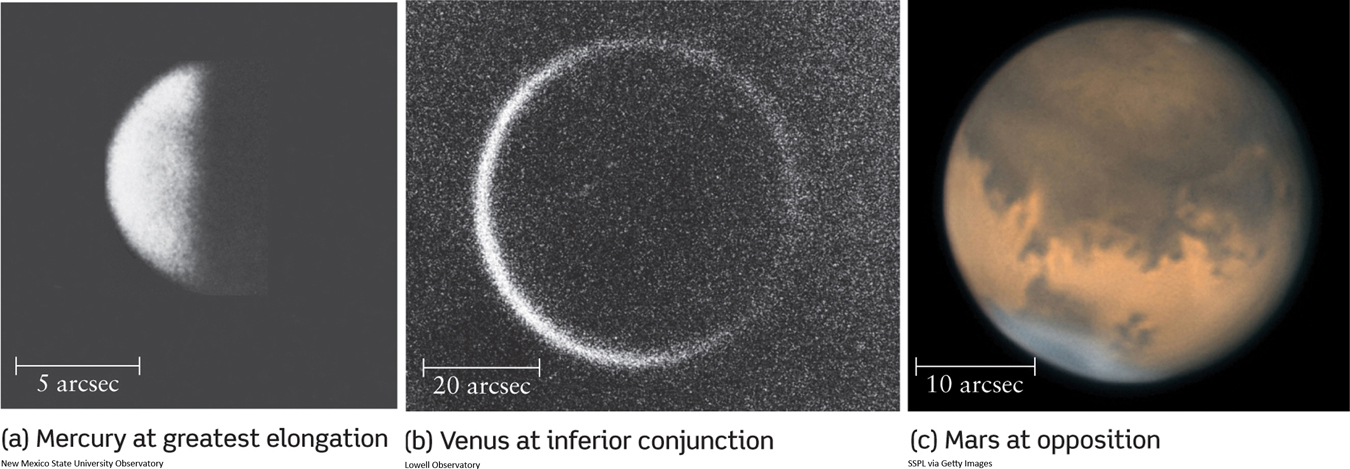6-1 Comparing terrestrial planets and moons shows distinct similarities and dramatic differences in appearance
If some Earth-gazing alien astronomers observe Earth from the scorching surface of Mercury, from above the dense clouds shrouding Venus, or from atop gigantic mountains of Mars with the same telescope technology available to our own astronomers, what might they be able to see? Using today’s Earth-based technology from those vantage points, an astronomer would be unable to pick out any specific features or landforms on Earth less than a few hundred miles across. In much the same way, Earth astronomers face the same limitations in studying the other terrestrial planets and moons. To truly understand these other worlds, it is essential to study them using the most modern telescopes or, even better, at close range using spacecraft. Telescopes reveal that the rocky planets near the Sun, and some of the moons orbiting the outer planets, do have surface features similar to, and sometimes quite different from, our home planet.
Tiny planet Mercury is the planet closest to the Sun. Whereas naked-eye observations of Mercury are best made at dusk or dawn when the Sun is blocked by Earth’s horizon, you might be surprised to discover that the best telescopic views are obtained in the daytime, when the planet is high in the sky, far above the degrading atmospheric effects occurring near the horizon. The photograph in Figure 6-1a, which is among the finest Earth-based views of Mercury, was taken during daytime. Only recently has Mercury been visited close up by spacecraft, and, as of this writing, astronomers are still trying to uncover this tiny planet’s history.

While an Earth-based telescope reveals some curious surface details on Mercury, Venus appears almost completely featureless, with neither clearly noticeable continents nor mountains. It took astronomers some time to realize that they were not seeing the true surface of the planet. We now understand that Venus is covered by a thick, unbroken layer of clouds that hides the rugged nature of its waterless surface. A heat-capturing cloud layer also explains why Venus reflects such a large fraction of sunlight, making it shine brilliantly in the sky. Direct evidence that Venus has a thick atmosphere came when nineteenth-century astronomers observed Venus near the time of inferior conjunction. This is when Venus lies most nearly between Earth and the Sun, so that we see the planet lit from behind. As Figure 6-1b shows, sunlight is scattered by Venus’s atmosphere, producing a luminescent ring around the planet that would not otherwise be present. No such ring is seen around Mercury at inferior conjunction, which indicates that Mercury has no appreciable atmosphere.
143
Unlike cloud-shrouded Venus, Mars has a thin, almost cloudless atmosphere that permits a clear view of the surface. Under the right conditions, even a relatively small telescope can reveal substantial detail on the Martian surface. Figure 6-1c shows an image of Mars during 2003, when Mars’s orbit brought it closer to Earth than it had been in several thousand years. The thin strip of blue and orange around the right-hand edge of Mars in this image is caused by the Martian atmosphere. This image also shows that different parts of the Martian surface have different colors. Most striking are the whitish ice caps covering the Martian poles, which bear a striking resemblance to the Arctic and Antarctic polar regions on Earth.
What we can easily see is that the planets Mercury, Venus, and Mars have some similarities to Earth and our Moon, but some dramatic differences, too. What can we learn about these objects in terms of comparing them to Earth? There are clues to each terrestrial planet’s age and interior found etched into their surfaces, and these clues are the topics of our next two sections: impact craters, tectonics, and volcanism.
Question
ConceptCheck 6-1: If we build bigger visible light telescopes, will astronomers finally be able to see the surface of Venus?